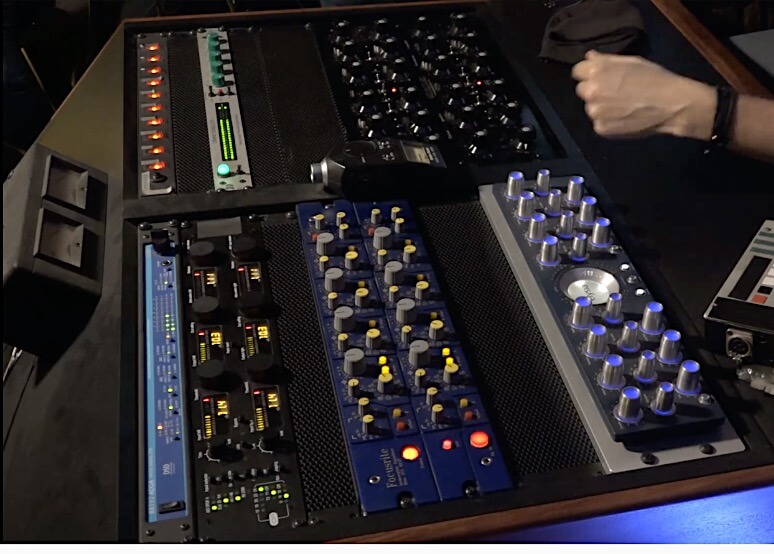"Mastering is not a fixing step, it's an enhancing step," says Brian Lucey in the video "Brian Lucey Mastering Royal Blood." Lucey's mastering approach combines art and science, with lots of emphasis on the former. "It's about musicality, it's about performance, it's not perfectionism," he explains.
The full video (available to Puremix Pro members) takes you step-by-step through Lucey's mastering workflow, as he recreates his work on Royal Blood's self-titled debut album. It provides a fascinating and informative look at the steps involved in mastering an album.
Back and Forth
Like many top mastering engineers, Lucey's workflow incorporates both the analog and digital realms. When mastering an album or multi-song project, his initial step is to load the songs into Magix Sequoia DAW software, so they're in the correct order. Then he gets a quick overview of the material by working on the transitions between songs (he refers to this as working on "tips and tails"), balancing levels and tweaking individual song EQs, among myriad other tasks.

Lucey uses Magix Sequoia as his DAW when mastering.
Eventually, he moves on to the analog phase of the process, where he runs the audio through several hardware processors. One of the changes he makes as the audio goes through the analog chain is to raise the gain. Unlike digital, which is totally unforgiving of anything over 0dBFS, you can get away with some overloading in analog.
Lucey then sends everything back into a Pacific Microsonics HDCD, a high-end digital-to-analog converter. It has a lot of headroom, so can handle the hot analog signal. Next, he uses digital processors for limiting and saturation, which is the topic we'll focus on in this article.
Limitations to the Process
With the signal back in digital form, Lucey sends it through a hardware Waves L-2 limiter on a reasonably mild setting. He sets the Threshold control to -1.4dB, which adds a corresponding amount of gain. He uses a fast release setting without linking the left and right channels. So technically, he's using a dual-mono signal path, rather than linked stereo.
The dual-mono setting means that peaks on the left channel won't impact the L2's behavior on the right side and vice versa. The fast release that he's using can create a pumping effect. But with relatively heavy rock material like this, it could add to the excitement.
Breaking Up is Simple
From the L2, the signal then passes into a Crane Song HEDD 192. HEDD is an acronym. It stands for Harmonically Enhanced Digital Device. It's a digital processor that emulates analog saturation and has settings for two types of tube saturation (Triode and Pentode) and tape saturation.
Lucey uses a minimal setting in for it, with Triode at 1, Pentode at 1 and Tape at 0. He says that he's trying to apply "musical roundness for the square waves that have been clipped and clipped again."

The analog processors used by Lucey.
What he's referring to is the clipping that occurred due to the raised gain from the analog stage. Clipped waveforms become more like square waves, which do not produce pleasant-sounding harmonic distortion.
The HEDD 192 (which, incidentally, is no longer made, it's been replaced by the HEDD Quantum), gives the signal a warmer, more tube-like saturation, instead. He explains that he's using the HEDD 192 as a "digital equivalent of an analog device."
Lucey explains that the saturation from the HEDD 192 helps the music to "jump out of the speakers," a little bit.
Going Easy
Avoiding extreme changes is a core principle that mastering engineers try to adhere to as much as possible.
As Lucey said, he's enhancing rather than fixing when he masters a project. As a result, subtlety is the name of the game. His processing with the HEDD 192 used subtle settings. The EQ adjustments he does in Sequoia in part 1 of the video are generally small. At the most, maybe 3dB of boost or cut, but usually much smaller increments. The Sequoia EQ is even capable of setting boosts or cuts to a hundredth of a dB. Now that's subtle.

The EQ adjustments Lucey made on one of the songs in the project.
One point Lucey makes in the video is that when he's EQing during mastering, he tries to leave the 500Hz to 1kHz range mainly unaffected, because that's where the most critical frequencies of the mix generally are, and he prefers not to interfere with the artist or mix engineer's vision for the song.
Pushing Lightly
As mentioned, Lucey used the Waves L2 to boost the gain a relatively small amount, 1.4dB. While it's certainly not insignificant, it's not extreme, either, and the L2 was only one of the stages in the signal chain where Lucey added gain.
The following example shows the effect of two different threshold settings on a mastering limiter (a Waves L3 Ultramaximizer plug-in).
Ex 1: In the first four measures, the limiter is bypassed. For measures 5 through 8, it's in with a -1.4 dB threshold setting. In measures 9 through 13, the Threshold goes to -3.1dB, which kicks the volume up significantly.
The next example features the kind of restrained EQ boosts and cuts that a mastering engineer might make. You'll see from the screenshot below, there's low shelf way down at 44Hz, with a 1.5dB boost, which helps solidify the bottom end. At 255Hz there's another 1.5dB boost, which is helping to fatten the snare a bit. On the high end is a small 0.5dB increase at 3.65kHz, and a high-shelf that's boosting slightly starting at 8.8kHz.
Ex. 2 The first four measures are without the EQ and the second four with.

The EQ settings for example 2.